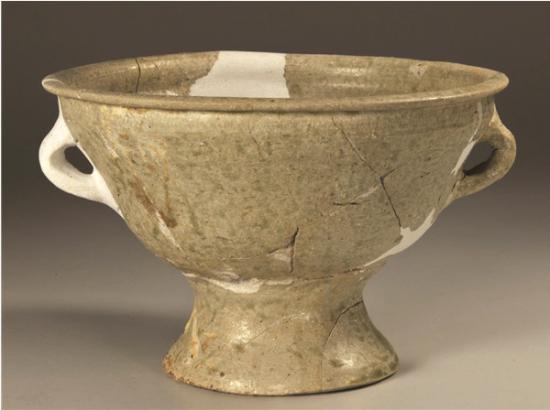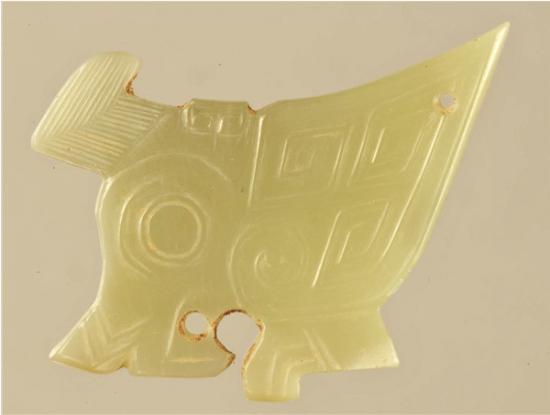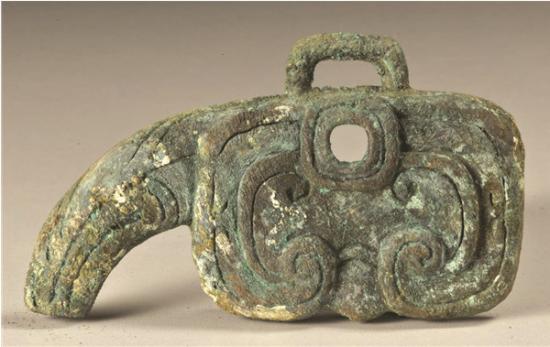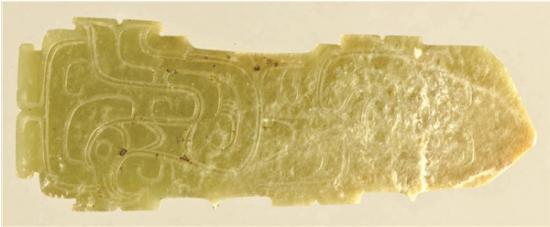Chinese Institute of Archaeology
Source - http://www.kaogu.cn/en/detail.asp?ProductID=3983
The Yaojia cemetery is located at the east margin in the intercross area of Shaanxi Qishan and Fufeng. It is about 400 meters west to the Meiyang River. From November 2011 to January 2013, Shaanxi Institute of Archaeology, Archaeology and Museology School of Peking University and Zhouyuan Museum jointly carried out large-scale archaeological drilling, excavation and investigation at the Yaojia cemetery and its surroundings.
The archaeological drilling confirmed the boundary of the Yaojia cemetery, and found 132 tombs and horses & chariots pits in all dating to the West Zhou Dynasty, including 2 large-scale tombs with a tomb passage respectively. This cemetery could be divided into the south and the north sections. The tombs in the north section mostly were in south-north direction and were large-scaled, while those in the south section were mostly in east-west direction and were small-scaled. The Yaojia cemetery is the only one which has clear boundary and tombs quantity in Zhouyuan site. It is especially emphasized that, comparing with the fact that only one tomb with a passage was found before in Zhouyuan site, the discovery of 2 tombs with tomb passage dating to the West Zhou period would be more helpful for studying the ranks and nature of the cemeteries at Zhouyuan site. The phenomenon that the tombs in south-north direction and those in east-west direction existed in the different section of the same one cemetery, was never seen in other cemeteries during the same period. This characteristic is similar to those found in capital settlements, such as Fenghao, Luoyang, Liulihe and Tianma-Qucun, but different from those found in elite feudal settlements, such as Zhougongmiao, Kongtougou. The cemetery plan layout in the south section is very different from that in the north section because the tombs in the south section were laid out in rows and columns while the tombs in the north section were laid out in disorder.

Based on the drilling information, the archaeological team excavated 2 large-scaled tombs with tomb passage, 44 middle- and small-scaled tombs without tomb passage and one horse pit in the north section. A large number of bronzes, jades and stone artifacts, bone and shell artifacts, proto-porcelain and pottery were excavated from the excavated middle- and small-scaled tombs although the tombs were heavily robbed. Most of the excavated bronzes were horse and chariot artifacts and weapons which were from the cemetery of north section. It is noted that many equisite jades and proto-porcelain were excavated from some middle- and small-scaled tombs, such as the jade tablet with dragon and phoenix pattern from burial M23, the jade parrot and jade tame beast from burial M18. Moreover, the proto-porcelain vessels簋gui,觯zhi,尊zun from burial M30, especially the first two types, were the first time to be discovered in Zhouyuan area, and even all over the country. They supplied new materials for exploring the origin of the proto-porcelain in North China which is an unsettled problem for a long time. In addition, a bronze mirror with concave surface 阳燧yangsui was excavated from burial M19. It is the second yangsui mirror excavated from Zhouyuan so far.

Regarding the characteristics of the tombs, the tombs found this time were basically same as the previously excavated tombs at Zhouyuan, but the features of the pottery tripot甗yan from a few tombs was first seen at Zhouyuan. The cemetery was started to be used from no later than the early stage of the middle phase of West Zhou period, and was continued to be used to the late phase of West Zhou. However, the result from the comparison between the tombs in two sections showed that the tombs in the north section did not have waist pit or sacrifice, and the grave weapons were destroyed; pottery only had li 鬲tripots and jars in some tombs. These were the characteristics of the Zhou culture. Among the 23 excavated tombs in south section, 7 tombs had waist pits and a few had sacrifice but no grave weapon was found. Most tombs were buried with several potteries which were the same type in even number. This was the characteristic of Shang dynasty tombs. Therefore, the clans of the tombs from the two sections were different but the relationship between them needs to be further studied.

The key for this excavation was the 2 large-scaled tombs with tomb passages in the north section. The two tombs both were special in structure. Each of the four corners of burial M7’s chamber had one narrow and short chute, which was similar to the tomb passages at four corners of burial M1193 in structure at the Beijing Liulihe site. The tomb passage of burial M8 was arch-shaped. The tombs with passage like M8’s were only found in the west district of Yin Ruin and the cemetery of Ying State. This phenomenon that the tombs with different structure’s passages existed in the same cemetery, was never seen in West Zhou cemetery. The two tombs were in south-north direction. The chamber was in the north and the passage was in the south. The passage was as wide as the chamber. No waist pit was found at the bottom of the tomb, neither was sacrifice found. However, the size of the tombs varied in a great range. Burial M7 was about 6.46 meters long and 3.86 meters wide at its opening. Its chamber was close to 25 square meters and its passage opening was about 25 meters long. However, burial M8 was 4.8 meters long and 3.6 meters wide at its opening. Its chamber was only about 18 square meters and its passage opening was 16.9 meters. It is noted that burial M7 was 11.2 meter deep and the bottom of the chute went straight to the top of the outer coffin in its chamber. Burial M8 was 13.6 meters deep. The joint area between the bottom of the tomb passage and the chamber lied in the middle of the tomb wall and was 7.5 meters away from the tomb opening. In terms of the coffins, these two tombs both had one inner coffin and one outer coffin. But on the north side of M7’s two coffins, there was a head box which was laid in east-west direction. The two tombs both were robbed heavily and the grave goods were mostly found in the robber holes, away from their original places. Only the wheels of the chariot and its bronze accessories and a few grave goods stayed in the original places. The grave goods include bronze chariots and horses parts, weapons, jade and stone artifacts, proto-porcelain, potteries, clam artifacts, bone and horn artifacts, sea shell, tortoise shell and so on. In addition, a small piece of gold foil was excavated from M7.

According to the characteristics of the excavated pottery, chariots and horses artifacts and the tombs structures, burial M7 could be dated to the late stage of middle West Zhou. Compared with M7, the chronology of burial M8 is a little earlier and could be the early stage of the middle West Zhou. There were weapons buried in these two tombs and one stone cong琮tube was excavated from M7. Based on the previous experience, the owner of the tomb should be male. However, the rank and clan of the tomb owner is still difficult to be identified due to the lack of the inscriptions. While, these two tombs were large-scaled and had passages, indicating that the status of these tombs owners was not lower than a king of a state, an important royal minister or an owner of high-rank feudal state. The number of its grave chariots is much less than burial M157 in the Jingshu 井叔cemetery, showing that the status of these tombs owners was lower than the later. In the whole, Yaojia cemetery and its sections, the owners of these two tombs seemed to be the highest rulers in this cemetery. According to the burial system which was to be buried by clans during West Zhou, the clans of the owners of the middle- and small-scaled tombs in the north section were the same as those of the large-scaled tombs but different from those of the small-scaled tombs in the south section. The middle-scaled tombs in the north section had many characteristics of the Zhou culture as analyzed above, therefore, we tend to consider that their clans belonged to Zhou.
In order to find the residential places and then further know the pattern of the settlement, the archaeological team amply investigated the east marginal area of the Zhouyuan site. The investigated area reached to about 8 square km. The investigate result preliminarily revealed the formation process of the remains dating to the West Zhou in this area and first confirmed the east border of the Zhouyuan site during the early West Zhou period, moreover, further make clear the east border of the settlement of the Zhouyuan site during the West Zhou. This investigation especially paid much attention to the survey and record in blank terraces and gap area. Also, this investigation paid much attention to the record of the regional micro-configuration and its formation reason. The function districts in the investigation area were roughly distinguished. It is concluded that the settlement pattern in the east marginal area of the Zhouyuan site was the residential area separate from the burial area, which was different from the features that residential area and burial area were in the same place in the center of the West Zhou settlement at Zhouyuan site.

On the basis of the investigation, the archaeological team drilled about 15 ha in Xujia north and Yaojia west. The small-scaled drilling in the Xujia north found 2 ditches, 7 tombs and some pits, and roughly confirmed the residential nature of this area. The large-scaled drilling in Yaojia west discovered a large number of residential remains and a few tombs, which not only confirmed the scope of this area, but also roughly knew the connotation of this residential area. The drill between these two sites made archaeologists know the gap between these two sites and make it confirmed that the residential remains in the two sites should belong to two different function districts.
In order to know the remains features at the two sites, the residential remains were test excavated in 108 square meters at the two sites. In the Yaojia west residential area found a workshop for producing antler horn arrows. As a result, not only the techniques and sequence of producing horn arrows were made clear, but also most of bone arrows previously discovered at Zhouyuan were re-considered to be horn arrows. This is the first time to find a horn arrow workshop dating to the West Zhou culture. In this workshop, the artifacts related to producing bone tablet-shaped decoration were discovered, showing that this workshop should produce other bone artifacts too. In addition, in a few ash pits in Yaojia west, three pottery moulds, a few bronze slag and two bronze-making implements—screw-shaped pottery pipes were discovered, indicating that bronze workshop should exist in this residential area or nearby. The discovery of these remains will be helpful for further studying the settlement handicraft at Zhouyuan settlement. (Translator: Zhai Shaodong)